Exploring Spatial Distribution of Pollen Allergenic Risk Zones in Urban China
Abstract
:1. Introduction
2. Background
2.1. Overview of Study Area
2.2. Study Materials
3. Study Methods
3.1. Processing of Remotely Sensed Images
3.1.1. Atmospheric Correction
3.1.2. Image Band Fusion
3.1.3. Partition and Stratification
3.2. Recognition of Tree Species
4. Results and Analysis
4.1. Recognition of Tree Species
4.1.1. Breeze-Ruffled Lotus at Quyuan Garden and Su Causeway Subarea
4.1.2. Solitary Hill and Bai Causeway Subarea
4.1.3. New Lakeside Subarea
4.2. Distribution of Pollen Allergenic Zones
5. Discussion and Conclusions
- (1)
- Using remote sensing technology, the overall accuracy of tree species recognition for the study area exceeds 86%.
- (2)
- Most plants in the study area flower during the spring, thus the pollen allergenic risk zones are also extensive during spring and sparse in fall.
- (3)
- As a complementary approach to traditional methods, the use of remote sensing technology is both time- and energy-efficient, and can provide highly effective, broad-range monitoring of the study area.
Acknowledgments
Author Contributions
Conflicts of Interest
References
- Casas, C.; Márquez, J.; Suárez-Cervera, M.; Seoane-Camba, J.A. Immunocytochemical localization of allergenic proteins in Parietaria judaica L. (Urticaceae) pollen grains. Eur. J. Cell Biol. 1996, 70, 179–188. [Google Scholar] [PubMed]
- Muñoz-Romo, M.; Sosa, M.; Quintero, Y.C. Digestibility of columnar cacti pollen grains in the glosophagine bats Glossophaga longirostris and Leptonycteris curasoae (Chiroptera: Phyllostomidae). Rev. Biol. Trop. 2005, 53, 277–280. [Google Scholar] [PubMed]
- Blagkley, C.H. Experimental Researches on the Causes and Nature of Catarrhus aEstivus (Hay-Fever or Hay-Asthma); Dawson: London, UK, 1959. [Google Scholar]
- Corren, J. Allergic rhinitis and asthma: How important is the link? J. Allergy Clin. Immunol. 1997, 99, S781–S786. [Google Scholar] [CrossRef]
- Ahlström-Emanuelsson, C.; Andersson, M.; Persson, C.; Schrewelius, C.; Greiff, L. Topical treatment with aqueous solutions of rofleponide palmitate and budesonide in a pollen-season model of allergic rhinitis. Clin. Exp. Allergy 2004, 34, 731–735. [Google Scholar] [CrossRef] [PubMed]
- Frenz, D.A. Volumetric ragweed pollen data for eight cities in the continental United States. Ann. Allergy Asthma Immunol. 1999, 82, 41–46. [Google Scholar] [CrossRef]
- Zhang, Y.; Bielory, L.; Mi, Z.; Cai, T.; Robock, A.; Georgopoulos, P. Allergenic pollen season variations in the past two decades under changing climate in the United States. Glob. Chang. Biol. 2015, 21, 1581–1589. [Google Scholar] [CrossRef] [PubMed]
- Tarragó, I.B. An annual study of airborne pollen in northern Mexico City. Aerobiologia 1996, 12, 191–195. [Google Scholar] [CrossRef]
- Ordaz, V.A.; Castañeda, C.B.; Campos, C.L.; Rodríguez, V.M.; Saens, J.G.; Ríos, P.C. Asthmatic exacerbations and environmental pollen concentration in La Comarca Lagunera (Mexico). Rev. Alerg. Mex. 1998, 45, 106–111. [Google Scholar] [PubMed]
- Carosso, A.; Gallesio, M.T. Allergy to ragweed: Clinical relevance in Turin. Aerobiologia 2000, 16, 155–158. [Google Scholar] [CrossRef]
- Nishihata, S.; Inouye, S.; Saiga, T.; Sahashi, N.; Suzuki, S.; Murayama, K.; Yokoyama, T.; Saito, Y. Prevalence rate of allergy to Japanese cedar pollen in Tokyo—From field investigation in 1996 by Tokyo Japanese Cedar Pollen Allergy Measurements and Review Committee. Arerugi 1999, 48, 597–604. [Google Scholar] [PubMed]
- Shi, Q.M.; Xiang, J.S.; Shu, H. Distribution of airborne allergenic pollen around parks and the relationship between airborne allergenic pollen and pollinosis. J. Clin. Otolaryngol. 1997, 11, 314–316. [Google Scholar]
- Ishizaki, T.; Koizumi, K.; Ikemori, R.; Ishiyama, Y.; Kushibiki, E. Studies of prevalence of Japanese cedar pollinosis among the residents in a densely cultivated area. Ann. Allergy 1987, 58, 265–270. [Google Scholar] [PubMed]
- Ye, S.T.; Zhang, J.T.; Qiao, B.S.; Lu, Y.J. Airborne and Allergenic Pollen Grains in China; Scientific Press: Beijing, China, 1998; pp. 1–3. [Google Scholar]
- Zhang, D. Application Research of Beijing area from 1 to 4 concentration prediction of trichosanthin. Meteorology 2010, 36, 128–132. [Google Scholar]
- Laaidi, M.; Thibaudon, M.; Besancenot, J.P. Two statistical approaches to forecasting the start and duration of the pollen season of Ambrosia in the area of Lyon (France). Int. J. Biometeorol. 2003, 48, 65–73. [Google Scholar] [CrossRef] [PubMed]
- Lacey, J.; Venette, J. Outdoor air sampling techniques. In Bioaerosols Handbook; CRC Press: Boca Raton, FL, USA, 1995; pp. 407–471. [Google Scholar]
- Grote, M.; Vrtala, S.; Niederberger, V.; Wiermann, R.; Valenta, R.; Reichelt, R. Release of allergen-bearing cytoplasm from hydrated pollen: A mechanism common to a variety of grass (Poaceae) species revealed by electron microscopy. J. Allergy Clin. Immunol. 2001, 108, 109–115. [Google Scholar] [CrossRef] [PubMed]
- Yu, Y.; Cheng, S. Species and distribution of airborne pollen plants in major citys of China. Chin. J. Clin. Immunol. Allergy 2015, 2, 136–141. [Google Scholar]
- Ernst, C.L.; Hoffer, R.M. Using Landsat MSS [multispectral scanner] data with soils information to identify wetland habitats [Vegetation types]. In Proceedings of the 5th Annual William T. Pecora Memorial Symposium on Remote Sensing, Sioux Falls, SD, USA, 10–15 June 1979.
- Townsend, P.A.; Walsh, S.J. Remote sensing of forested wetlands: Application of multitemporal and multispectral satellite imagery to determine plant community composition and structure in southeastern USA. Plant Ecol. 2001, 157, 129–149. [Google Scholar] [CrossRef]
- Hagens, J.S. Object-Oriented and Pixel-Based Image Classification Using Landsat Multispectral and Hyperion Hyperspectral Imagery in Boreal Conditions; Lakehead University: Thunder Bay, ON, Canada, 2008. [Google Scholar]
- Peddle, D.R. An empirical comparison of evidential reasoning, linear discriminant analysis, and maximum likelihood algorithms for alpine land cover classification. Can. J. Remote Sens. 1993, 19, 31–44. [Google Scholar] [CrossRef]
- Franklin, S.E.; Peddle, D.R. Classification of SPOT HRV imagery and texture features. Int. J. Remote Sens. 1990, 11, 551–556. [Google Scholar] [CrossRef]
- Haralick, R.M.; Shanmugam, K.; Dinstein, I.H. Texture Features for Image Classification. IEEE Trans. Syst. Man Cybern. 1975, 3, 610–621. [Google Scholar] [CrossRef]
- Sefercik, U.G.; Alkan, M.; Buyuksalih, G.; Jacobsen, K. Generation and validation of high-resolution DEMs from Worldview-2 stereo data. Photogramm. Rec. 2013, 28, 362–374. [Google Scholar] [CrossRef]
- Ghosh, A.; Joshi, P.K. A comparison of selected classification algorithms for mapping bamboo patches in lower Gangetic plains using very high resolution WorldView 2 imagery. Int. J. Appl. Earth Obs. Geoinform. 2014, 26, 298–311. [Google Scholar] [CrossRef]
- Maheswary, P.; Srivastava, N. Retrieval of Remote Sensing Images Using Colour and Texture Attribute. Comput. Sci. 2009, 4. [Google Scholar]
- Doi, R. Simple luminosity normalization of greenness, yellowness and redness/greenness for comparison of leaf spectral profiles in multi-temporally acquired remote sensing images. J. Biosci. 2012, 37, 723–730. [Google Scholar] [CrossRef] [PubMed]
- Qin, Q. The problem and solution of automatic interpretation of remote sensing image. J. Sci. Surv. Mapp. 2000, 25, 21–24. [Google Scholar]
- Kervrann, C.; Boulanger, J. Optimal spatial adaptation for patch-based image denoising. IEEE Trans. Image Process. 2006, 15, 2866–2878. [Google Scholar] [CrossRef] [PubMed]
- Bernstein, L.S.; Adler-Golden, S.M.; Sundberg, R.L.; Levine, R.Y.; Perkins, T.C.; Berk, A.; Ratkowski, A.J.; Felde, G.; Hoke, M.L. A New Method for Atmospheric Correction and Aerosol Optical Property Retrieval for VIS-SWIR Multi-and Hyperspectral Imaging Sensors: QUAC (Quick Atmospheric Correction); Spectral Sciences Inc.: Burlington, MA, USA, 2005. [Google Scholar]
- Shackelford, A.K.; Davis, C.H. Fully automated road network extraction from high-resolution satellite multispectral imagery. In Proceedings of the 2003 IEEE International Geoscience and Remote Sensing Symposium, Toulouse, France, 21–25 July 2003; pp. 461–463.
- Xin, J.; Ouyang, Z.; Zheng, H.; Wang, X.; Miao, H. Pollen sensitive plants in the city and its influencing factors. J. Ecol. 2007, 9, 3820–3827. [Google Scholar]
- Yang, Y. Study on Trees Pollen Dispersal Regulation and Affecting Factors in Beijing City; Beijing Forestry University: Beijing, China, 2007. [Google Scholar]
- Cariñanos, P.; Casares-Porcel, M. Urban green zones and related pollen allergy: A review. Some guidelines for designing spaces with low allergy impact. Landsc. Urban Plan. 2011, 101, 205–214. [Google Scholar] [CrossRef]
- Cariñanos, P.; Adinolfi, C.; Díaz de la Guardia, C.; De Linares, C.; Casares-Porcel, M. Characterization of Allergen Emission Sources in Urban Areas. J. Environ. Qual. 2015, 45, 289–290. [Google Scholar] [CrossRef] [PubMed]
- Asero, R. Birch and ragweed pollinosis north of Milan: A model to investigate the effects of exposure to “new” airborne allergens. Allergy 2002, 57, 1063–1066. [Google Scholar] [CrossRef] [PubMed]
- Galán, C.; Alcázar, H.; Dominguez, P. Meteorological variation effect on aerobiology—New tools on pollen forecasting. Eur. Ann. Allergy Clin. Immunol. 2006, 38, 203–208. [Google Scholar] [PubMed]
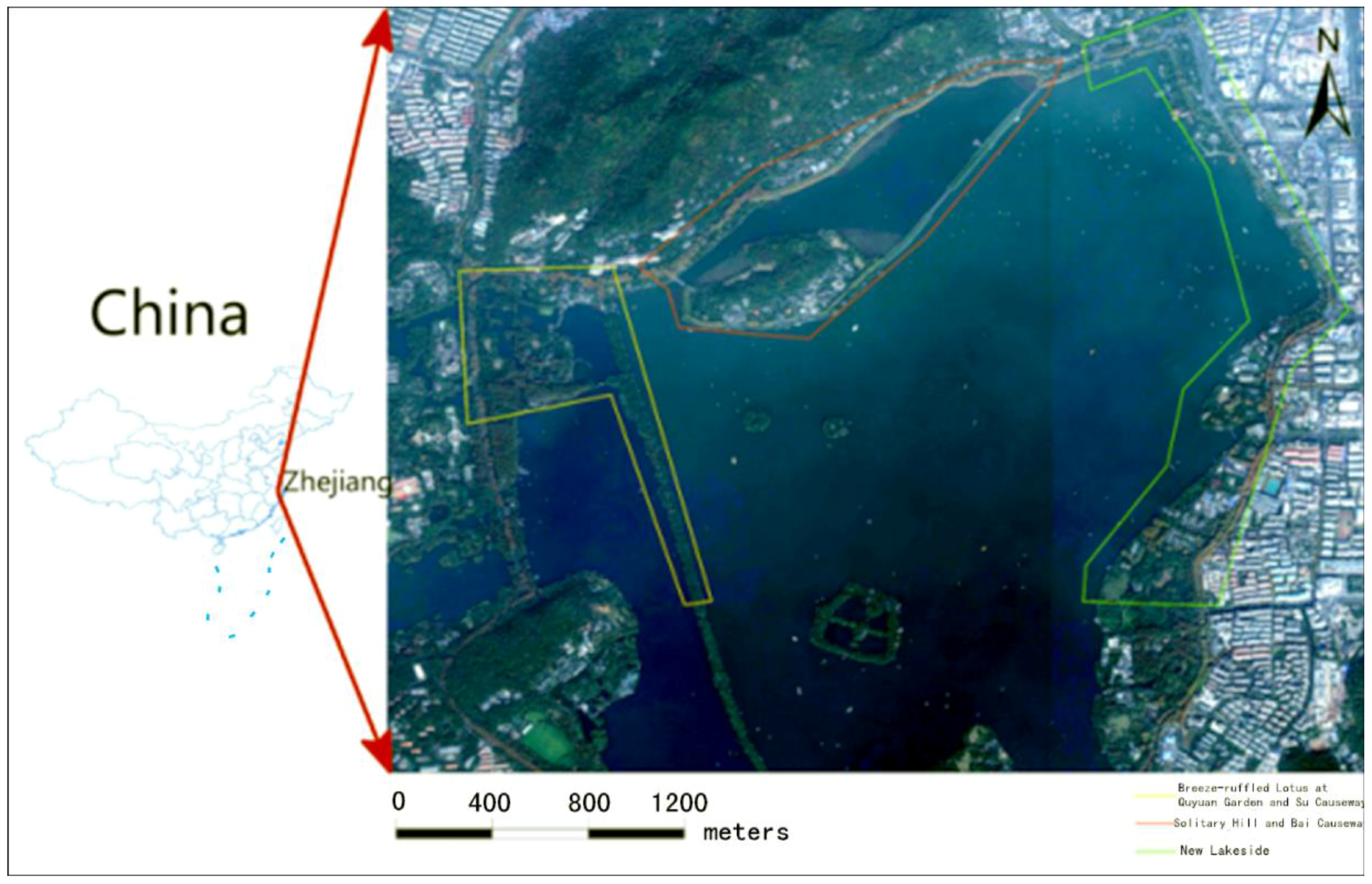
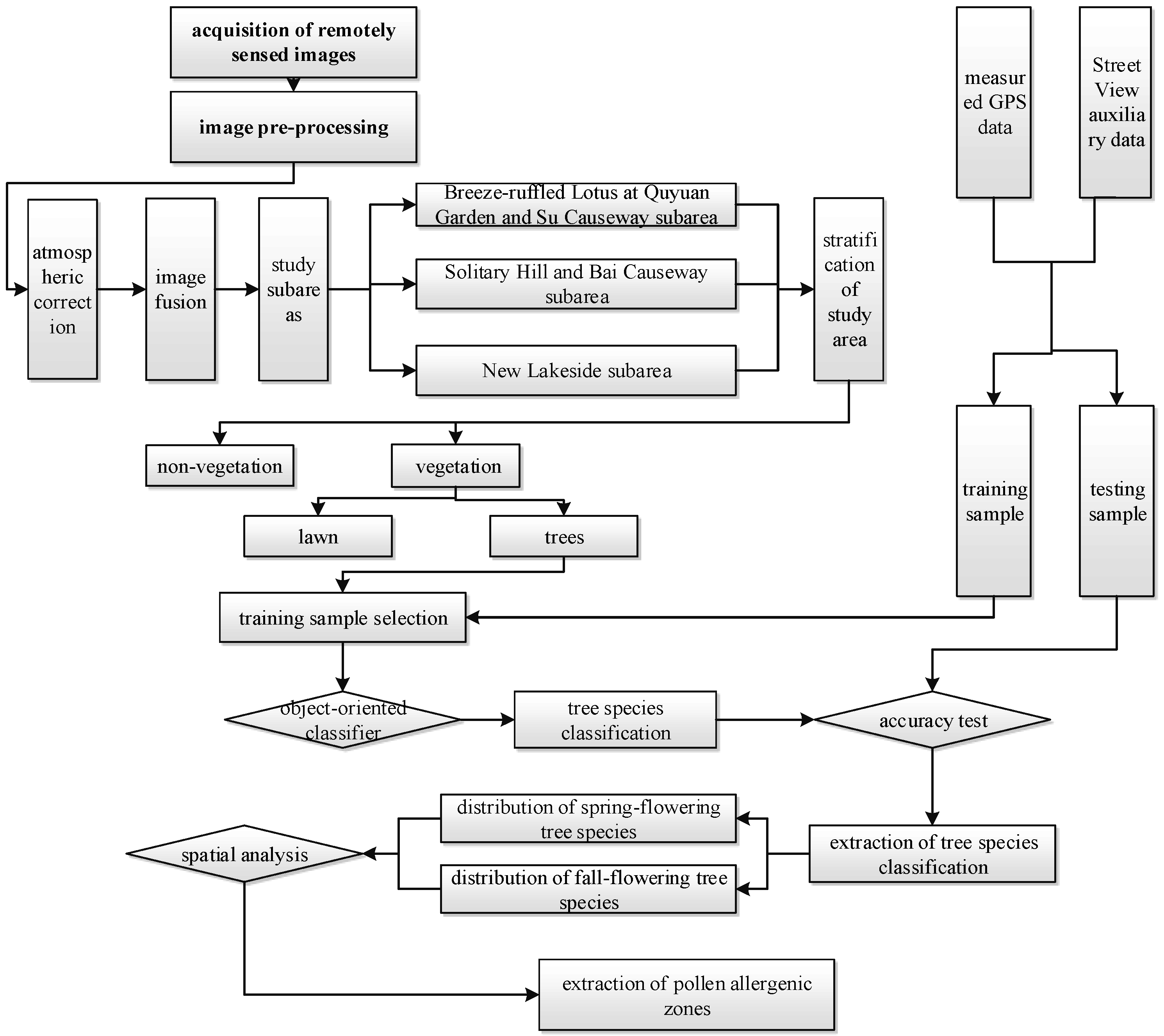
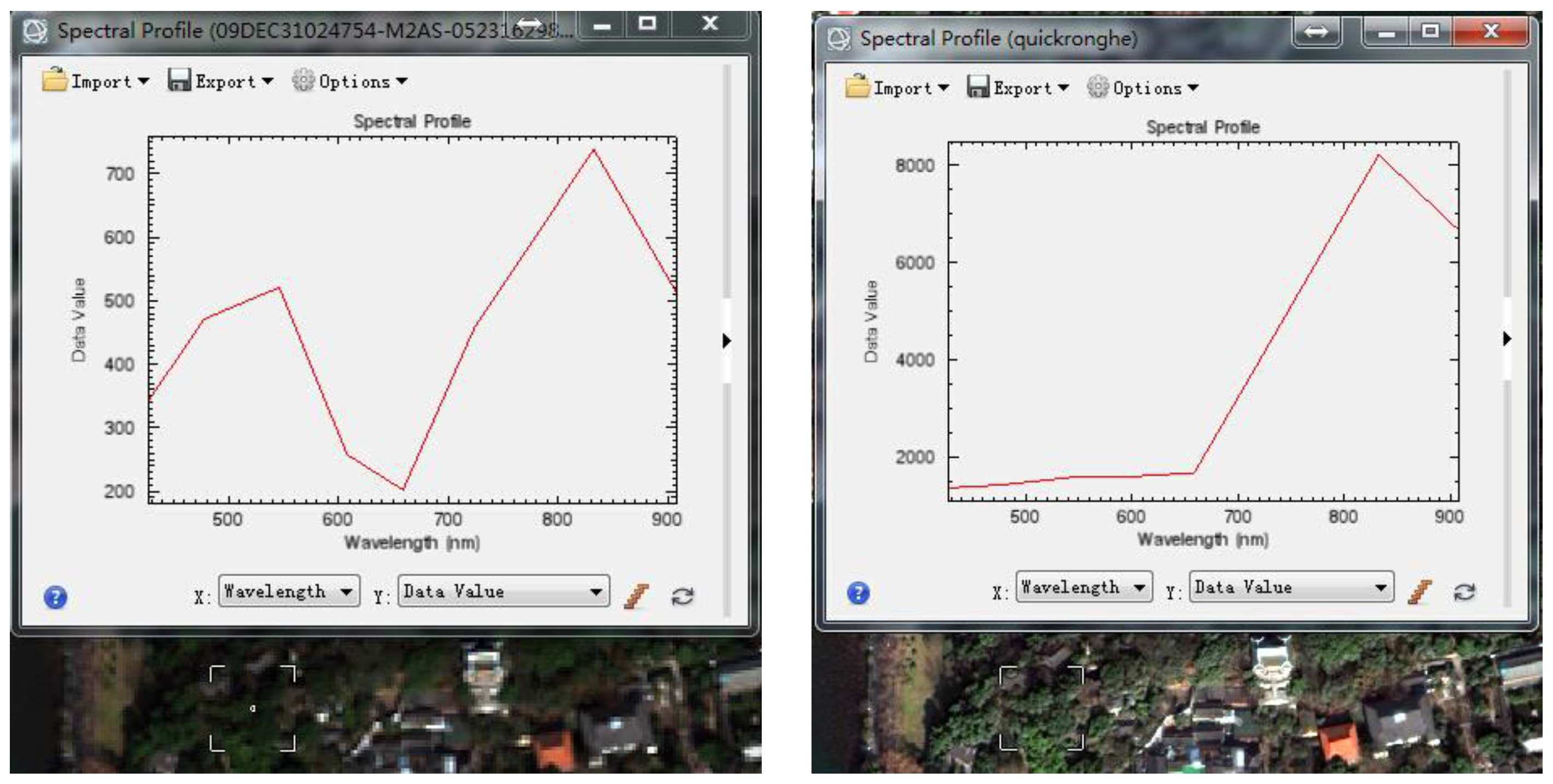
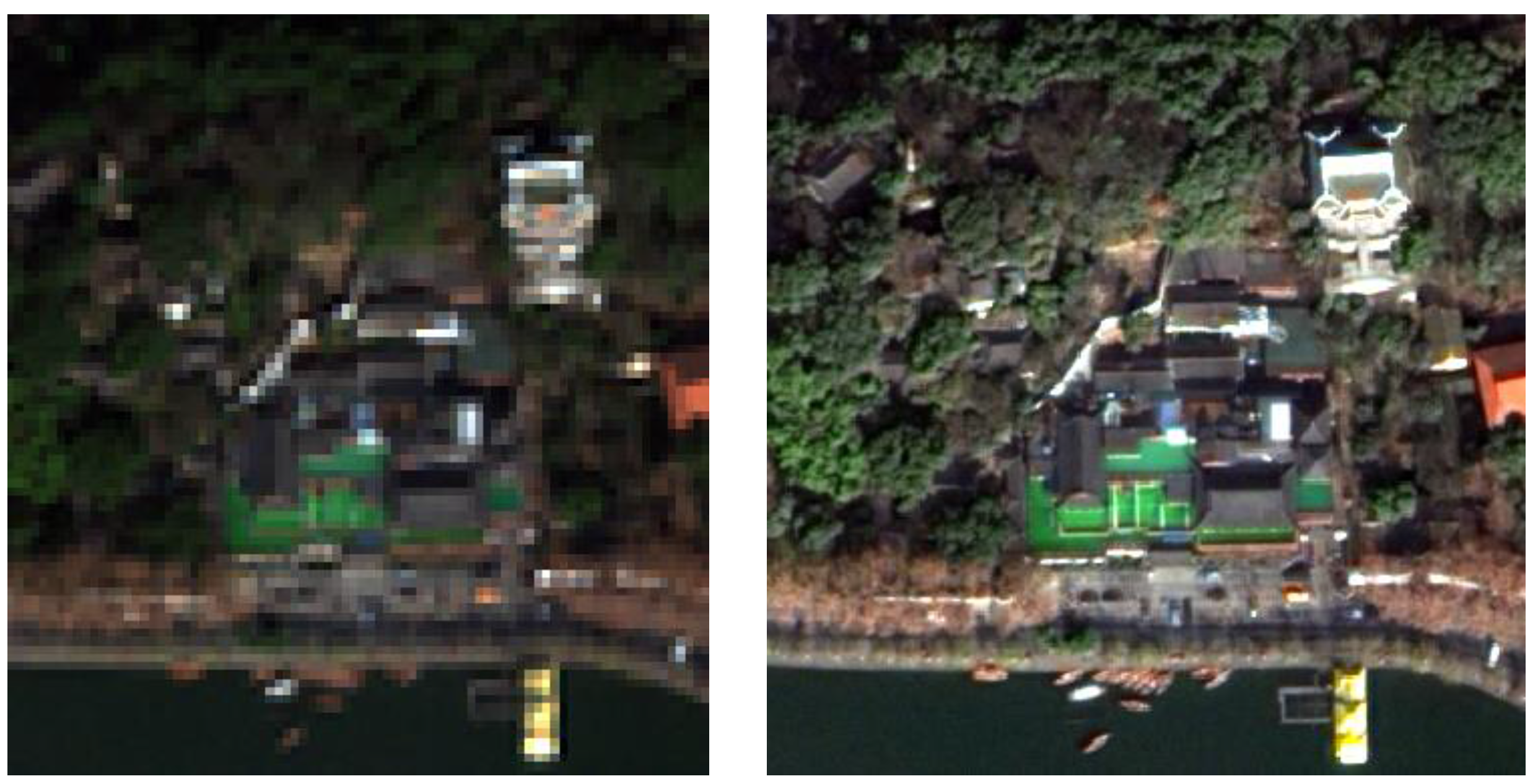

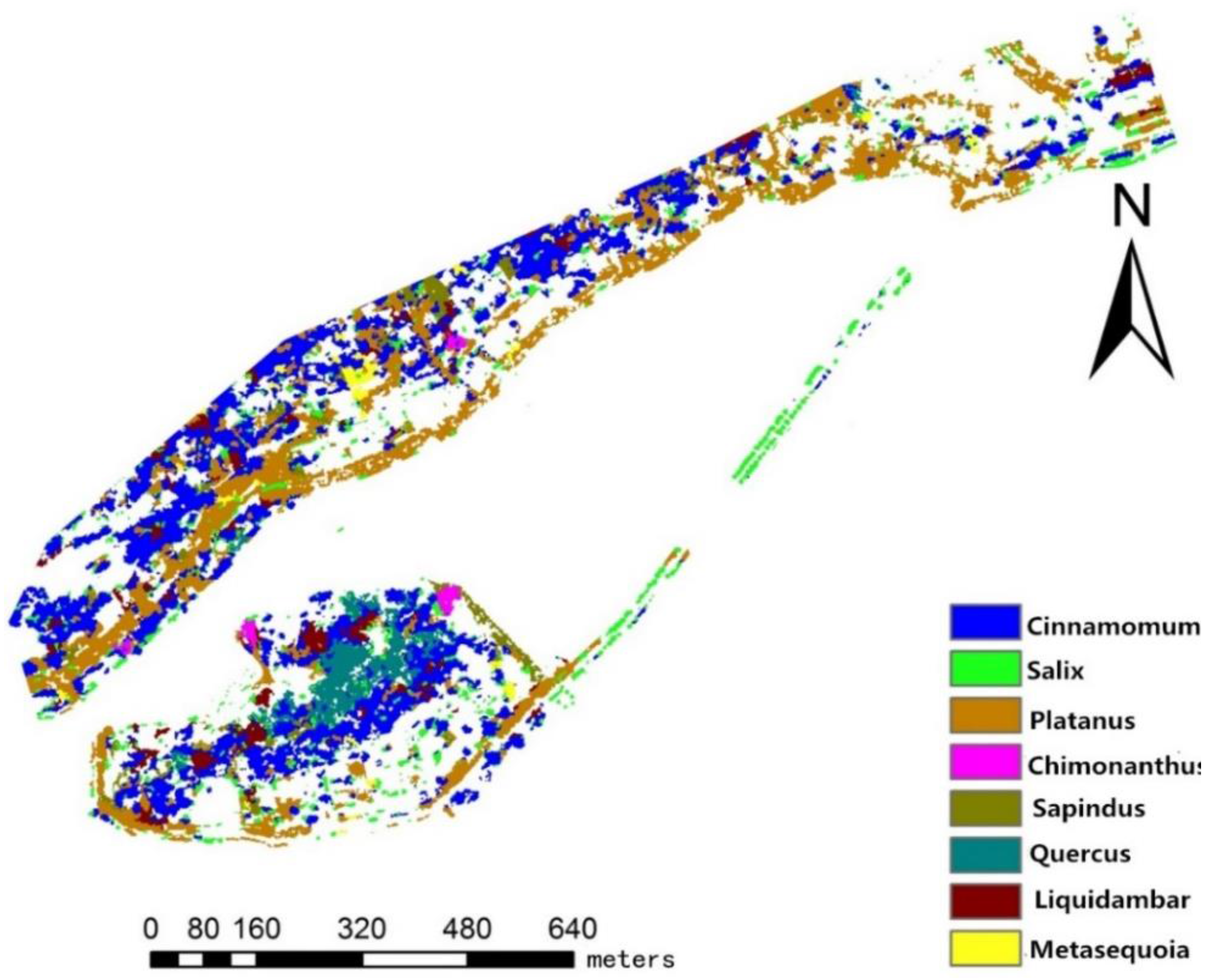
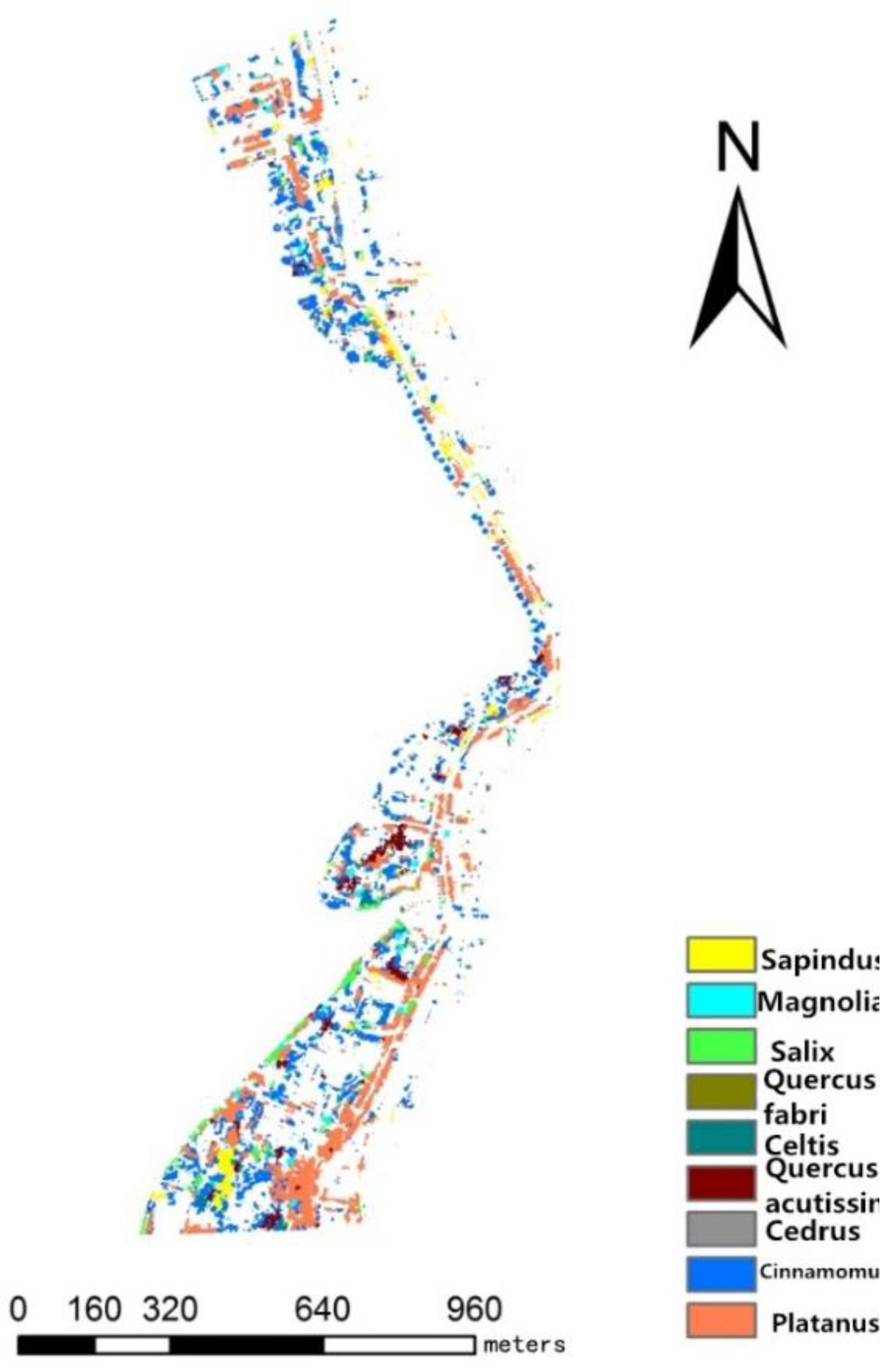
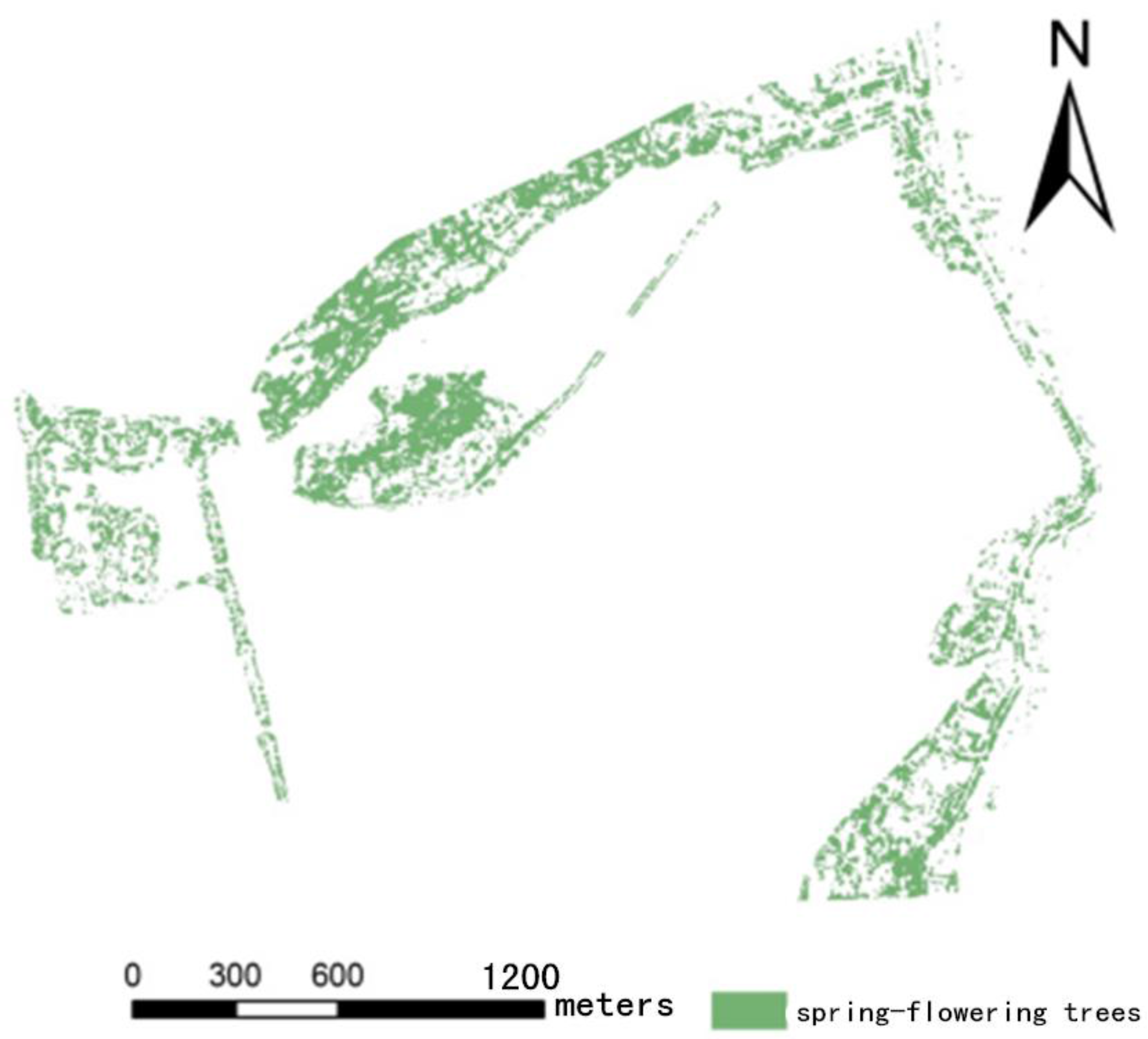
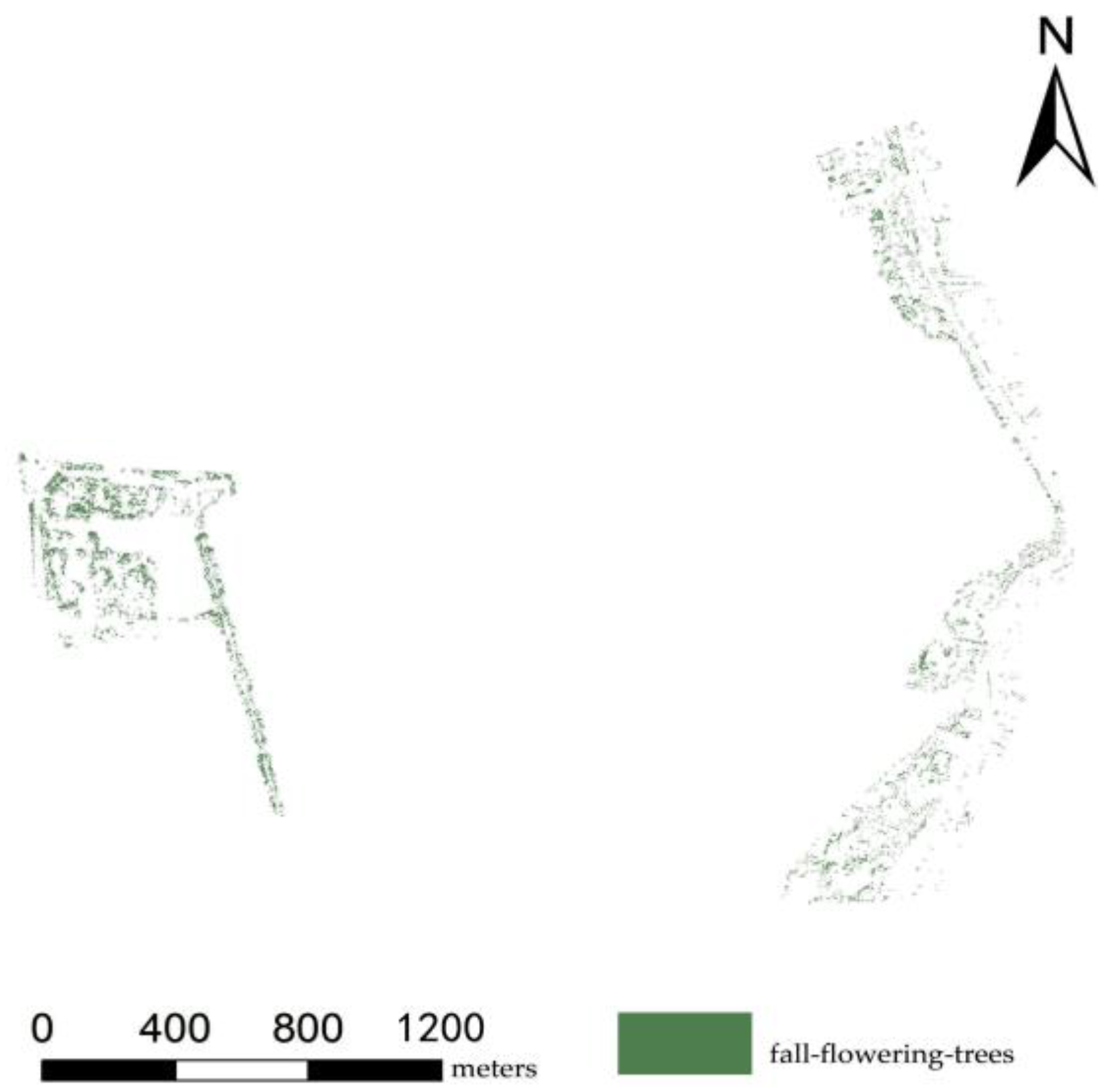

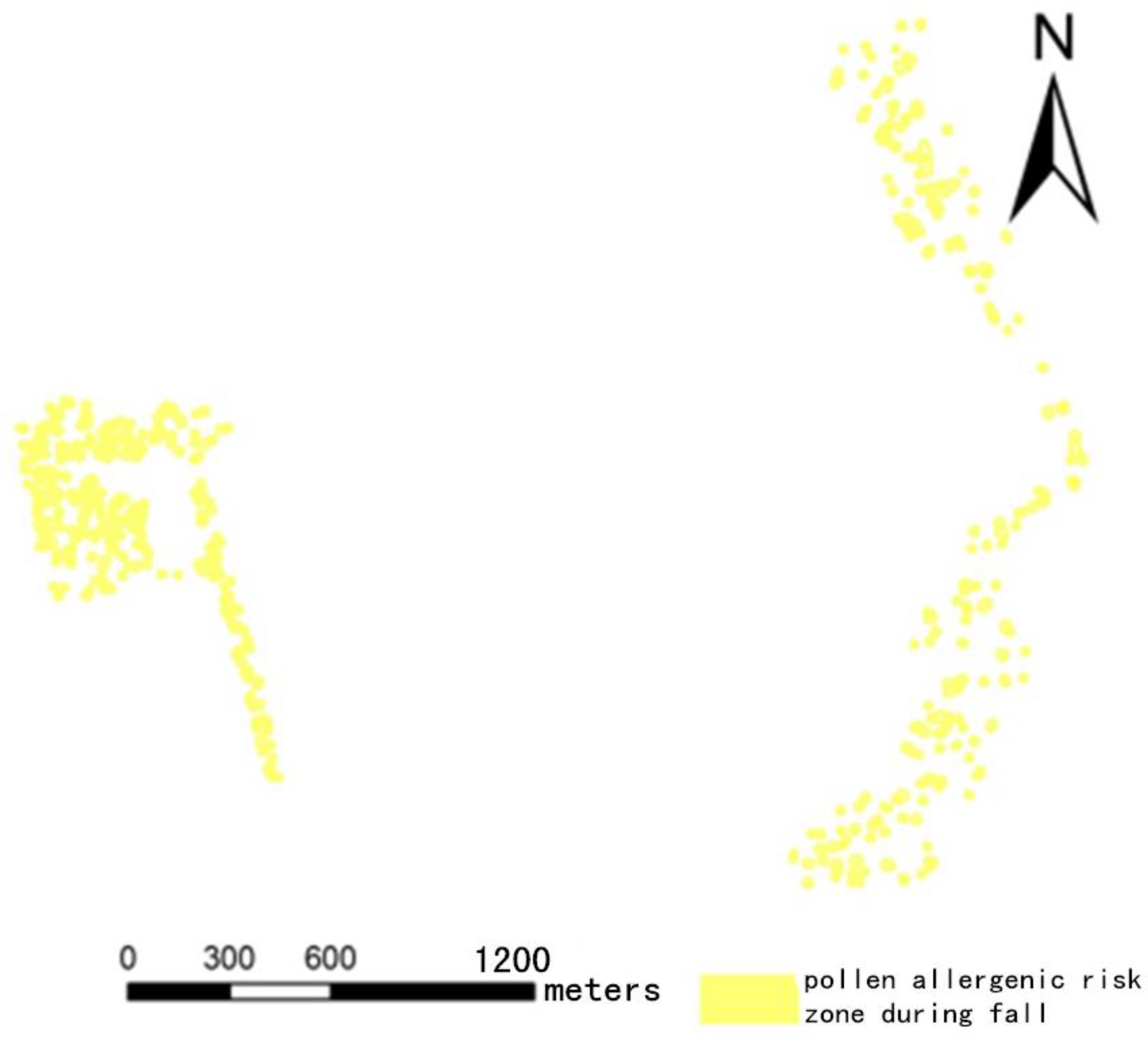
| Tree Species | Interpretation Marker | Tree Species | Interpretation Marker |
|---|---|---|---|
| Platanus acerifolia Willd. |  | Magnolia grandiflora Linn. |  |
| Camphor (Cinnamomum camphora (L.) Presl.) |  | Celtis sinensis Pers. |  |
| Metasequoia glyptostroboides Hu et Cheng |  | Liquidambar formosana |  |
| Osmanthus fragrans |  | Salix babylonica L. |  |
| Sapindus mukorossi Gaertn. |  | White oak (Quercus fabri Hance) |  |
| Cedrus deodara (Roxb.) G.Don |  | Quercus acutissima Carruth. |  |
| Plum (Chimonanthus praecox (Linn.) Link) |  | Peach (Amygdalus persica L.) |  |
| Tree species | Prod. Accuracy (Percent) | User Accuracy (Percent) | Overall Accuracy | Kappa Coefficient |
|---|---|---|---|---|
| Osmanthus fragrans | 97.94 | 74.61 | 86.00% | 80.00% |
| Metasequoia glyptostroboides Hu et Cheng | 85.80 | 88.65 | ||
| Cinnamomum camphora (L.) Presl. | 80.09 | 97.54 | ||
| Platanus acerifolia Willd. | 89.42 | 89.77 | ||
| Sapindus mukorossi Gaertn. | 100.00 | 36.45 | ||
| Quercus acutissima Carruth. | 69.01 | 79.03 | ||
| Salix babylonica L. | 100.00 | 26.78 |
| Tree species | Prod. Accuracy (Percent) | User Accuracy (Percent) | Overall Accuracy | Kappa Coefficient |
|---|---|---|---|---|
| Chimonanthus praecox (Linn.) Link | 96.52 | 100.00 | 90.36% | 86.93% |
| Metasequoia glyptostroboides Hu et Cheng | 100.00 | 100.00 | ||
| Cinnamomum camphora (L.) Presl. | 96.72 | 98.36 | ||
| Platanus acerifolia Willd. | 100.00 | 93.62 | ||
| Sapindus mukorossi Gaertn. | 20.77 | 100.00 | ||
| Quercus acutissima Carruth. | 100.00 | 66.77 | ||
| Salix babylonica L. | 96.85 | 94.96 | ||
| Liquidambar formosana | 10.92 | 27.15 |
| Tree Species | Prod. Accuracy (Percent) | User Accuracy (Percent) | Overall Accuracy | Kappa Coefficient |
|---|---|---|---|---|
| Magnolia grandiflora Linn. | 91.82 | 61.96 | 86.05% | 79.78% |
| Cinnamomum camphora (L.) Presl. | 97.14 | 88.80 | ||
| Platanus acerifolia Willd. | 99.67 | 81.84 | ||
| Sapindus mukorossi Gaertn. | 100.00 | 36.45 | ||
| Quercus acutissima Carruth. | 77.44 | 100.00 | ||
| Cedrus deodara (Roxb.) G.Don | 100.00 | 26.78 | ||
| Celtis sinensis Pers. | 75.36 | 65.25 | ||
| Salix babylonica L. | 86.68 | 87.35 |
© 2016 by the authors; licensee MDPI, Basel, Switzerland. This article is an open access article distributed under the terms and conditions of the Creative Commons Attribution (CC-BY) license (http://creativecommons.org/licenses/by/4.0/).
Share and Cite
Xu, J.; Cai, Z.; Wang, T.; Liu, G.; Tang, P.; Ye, X. Exploring Spatial Distribution of Pollen Allergenic Risk Zones in Urban China. Sustainability 2016, 8, 978. https://doi.org/10.3390/su8100978
Xu J, Cai Z, Wang T, Liu G, Tang P, Ye X. Exploring Spatial Distribution of Pollen Allergenic Risk Zones in Urban China. Sustainability. 2016; 8(10):978. https://doi.org/10.3390/su8100978
Chicago/Turabian StyleXu, Junfeng, Zhanqing Cai, Tiantian Wang, Guang Liu, Peng Tang, and Xinyue Ye. 2016. "Exploring Spatial Distribution of Pollen Allergenic Risk Zones in Urban China" Sustainability 8, no. 10: 978. https://doi.org/10.3390/su8100978






